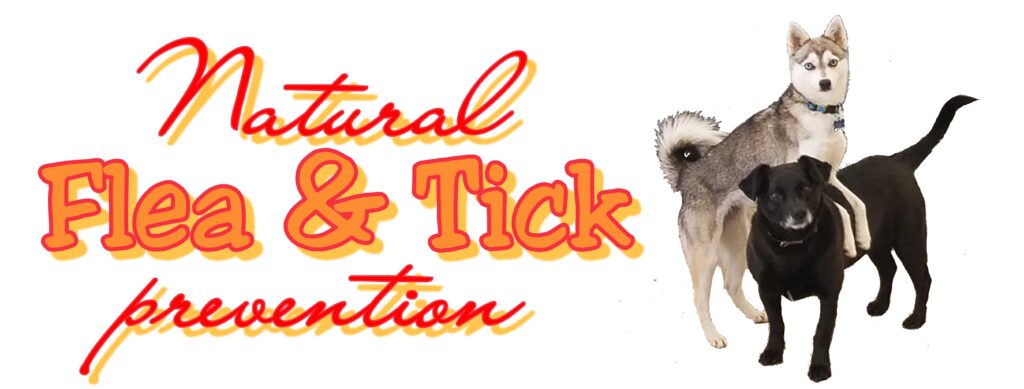
Natural Flea and Tick
(And all the added yuckiness of chemical treatments)
By: Cailee Jones
You’ve probably experienced this scene before, you’re calmly sitting on the couch with your
beloved pooch when you notice frantic scratching… and wait! Did something just move? And suddenly both you and your dog are grumpily fighting the plague of fleas that seemingly came from nowhere. Fleas are a common occurrence, and you will most likely have to deal with them at least once. They’re nothing to just shake off, we’ve seen untreated flea infestations on dogs who are covered in sores, bites, and flea remains. It is not a pretty picture. The usual solution is the dog has a flea collar unwillingly slapped on, or a chemical treatment sprayed over him/her. The issue with that is what these treatments contain, and it’s not just dangerous for our pets. Scientists have found traces of organophosphates and carbamates, which have been verified to cause learning disabilities in children. In fact, most flea treatments are created with pesticides, and most of those pesticides are not safe.
Actually, the most commonly used flea treatment (collars) are some of the most dangerous and are in the process of being banned completely. These collars can contain chemicals such as tetrachlorvinphos, carbaryl, and propoxur. Tetrachlorvinphos has been labeled by the EPA as “likely carcinogenic to humans”. And we let this sit on our dog’s skin. Carbaryl and propoxur are again, more dangerous to the human counterparts. The EPA has labeled both of these carbamates as “probable human carcinogen”. Carbamates have also been found to harm nervous systems. This is especially dangerous to cats, as they do not have enzymes to detoxify themselves and ingest these chemicals directly while grooming themselves. Most other flea and tick products also use potential carcinogens and chemicals like fipronil, permethrin, pyrethrin’s, or imidacloprid are considered neuro-system toxins.
Oral treatments can be just as dangerous. Frontline contains the active ingredient fipronil, as mentioned before, which tends to stay in the dog’s system long term. Tests found that animals that had fipronil in their system has issues like thyroid cancer, liver toxicity, reduced fertility, and even convulsions. Apparently, Frontline encourages the idea that the treatment simply stays in the oil glands of the animal, but what this study found is that actually, that is not true. Advantage is similar, but instead it contains a chemical called imidacloprid. Imidacloprid can increase cholesterol, cause thyroid lesions, heart damage, brain damage, incoordination, labored breathing, and muscle weakness. These chemicals are under more and more investigation, but the issue is that vets trust that the EPA will not allow the use of dangerous pesticides. Obviously, this is untrue so far as many studies have proved the dangers of those listed above with no word from the EPA.
The ever-cheesy statement I will tell you is, the best (and safest) treatment will always be prevention. This can be extremely difficult with fleas, but is still possible. This means keeping a vigilant eye on your house and your surroundings. Fleas like a warm, moist, and shady environment and especially like to be near where your dogs will be. This means consistent checks of outdoor areas, and reaction at the first sight of a flea. This also means being careful with what dogs your dog interacts with, as fleas transmit very easily and very quickly. If you have your suspicions, it is better to avoid the potentially infected dog. If, despite this, you still get fleas in your house, it is unavoidable to treat the environment. After treating you house and letting it sit for as long as necessary, do a run through and clean house and look for any places fleas or offspring may have been left. There are several tools you can use alongside all-natural flea treatments to help rid your dog of these pesky parasites.
A pretty straight forward solution is a flea comb. These are really straight forward to use and can be completely non-invasive if used properly. You just gently run the comb over your dog repeatedly, stopping if you see you have a flea stuck in the comb. Some people prefer to pull the flea off and throw it in a bowl of water, or you can just dunk the comb in a bowl of soapy water. Then, just keep combing. A couple of options that we have here at the Yuppy Puppy work wonderfully as well. We have all-natural flea spray and shampoo. These are made out of a combination of spices that are known to be natural flea repellents. It features ingredients such as, peppermint, cedar, clove, rosemary, and cinnamon. So not only is it all natural and pet-safe, it makes your furry friend smell amazing. This specific brand, Top Performance, comes in either a convenient spray or shampoo form. This is one of my favorite flea and tick preventatives and has worked wonders for my dog, not one flea or tick anywhere on him, despite our woodland romps. Another option we have is our Insect Shield bandanas, neck gators, and shirts. Another wonderful, all-natural preventative to keep those icky bugs away from your pet. And actually, both of these also help repel mosquitoes, black flies, and other flies. The Insect Shield are not cat-safe however. The Insect Shield brand also has blankets if you ever want to have a bug-free picnic in the park. All in all, we have several pet-safe chemical free insect repellants available and we would love to help you find the best option for your pet, so come on in to the Yuppy Puppy!
Bibliography:
“Flea Control and Prevention for Dogs.” Pet Education Dogs,
www.peteducation.com/article.cfm?c=2%2B2111&aid=591.
“Flea and Tick Product Ingredients: What You Should Know.” The Humane Society of the United States,
www.humanesociety.org/animals/resources/tips/flea_tick_OTC_pet_products.html?referrer=https%3A
%2F%2Fwww.google.com%2F.
January 22, 2016 Karen Smith-Janssen.
“Nontoxic Ways to Protect Your Pet.” NRDC, 27 Nov. 2017,
www.nrdc.org/stories/nontoxic-ways-protect-your-pet.
“The Dangers Of Flea And Tick Products.” Dogs Naturally Magazine, 14 Feb. 2015,
www.dogsnaturallymagazine.com/the-dangers-of-flea-and-tick-products/.
